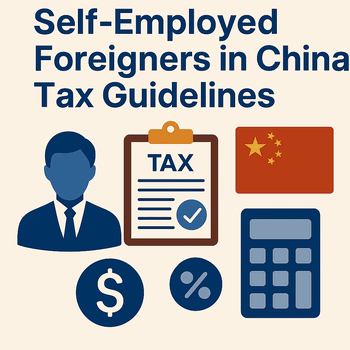
Navigating China’s tax system as a self-employed foreigner requires understanding complex regulations that vary based on business structure, residency status, and income sources.
With significant tax reforms in recent years and regional variations across China, staying compliant while optimizing your tax position demands current, detailed knowledge.
This comprehensive 2025 guide covers essential tax obligations, business structures, the fapiao system, and practical compliance strategies for freelancers, consultants, and entrepreneurs operating in China.
Business Structures for Foreigners in China
Before addressing tax obligations, it’s crucial to understand the available business structures, as each carries different tax implications:
| Business Structure | Key Features | Tax Implications | Best For |
|---|---|---|---|
| Individual Sole Proprietorship (个体工商户) | Simplest structure, limited liability protection | Subject to progressive IIT rates (3-45%) | Small-scale freelancers, consultants |
| Wholly Foreign-Owned Enterprise (WFOE) | Limited liability company, 100% foreign ownership | Corporate Income Tax (25%), dividend withholding tax | Medium to large operations requiring full business scope |
| Representative Office | Cannot generate revenue directly in China | Tax on deemed profit (typically 15% of expenses) | Market research, liaison activities |
| Joint Venture | Partnership with Chinese entity | Corporate Income Tax (25%), profit sharing based on ownership | Businesses requiring local partnerships |
| Foreign Independent Contractor | Contract-based work for Chinese companies | IIT on China-sourced income | Remote workers, project-based consultants |
Source: An Introduction to Doing Business in China 2025
Tax Residency Status and Its Implications
Your tax obligations depend significantly on your residency status:
Determining Tax Residency
- Non-resident: Staying in China for less than 183 days in a calendar year
- Resident: Staying in China for 183 days or more in a calendar year
The Six-Year Rule (Updated from Previous Five-Year Rule)
Foreign residents who have lived in China for less than six consecutive years can exempt their foreign-sourced income from Chinese taxation, provided they register with tax authorities and take a single absence from China exceeding 30 days or multiple absences totaling 90 days within a calendar year.
Source: State Taxation Administration – Tax Residency Rules, 2025
Individual Income Tax (IIT) for Self-Employed Foreigners
Current 2025 IIT Brackets
The following progressive tax rates apply to comprehensive income (including freelance income):
| Annual Taxable Income (CNY) | Tax Rate (%) | Quick Deduction (CNY) |
|---|---|---|
| 0 – 36,000 | 3% | 0 |
| 36,001 – 144,000 | 10% | 2,520 |
| 144,001 – 300,000 | 20% | 16,920 |
| 300,001 – 420,000 | 25% | 31,920 |
| 420,001 – 660,000 | 30% | 52,920 |
| 660,001 – 960,000 | 35% | 85,920 |
| Above 960,000 | 45% | 181,920 |
Source: State Taxation Administration – Individual Income Tax Calculator, 2025
Standard Deductions
- Basic deduction: CNY 60,000 per year (CNY 5,000 per month)
- Additional deductions for foreigners (transitioning out by 2026):
- Housing rental: Up to CNY 1,500-3,000 monthly (varies by city)
- Language training: Up to CNY 400 monthly
- Children’s education: CNY 1,000 per child monthly
- Continuing education: CNY 400 monthly
Value-Added Tax (VAT) System
Self-employed individuals providing goods or services may be subject to VAT:
Current VAT Rates (2025)
- 13%: Sale of most goods and repair services
- 9%: Transportation, construction, real estate leasing, and specific goods
- 6%: Modern services (including consulting, IT, and financial services)
- 0%: Certain exported services
Small-Scale VAT Taxpayer vs. General VAT Taxpayer
| Aspect | Small-Scale Taxpayer | General VAT Taxpayer |
|---|---|---|
| Annual Sales Threshold | Under CNY 5 million | Over CNY 5 million |
| VAT Rate | Simplified 3% rate | Standard rates (6%, 9%, 13%) |
| Input VAT Deduction | Not eligible | Can deduct input VAT |
| Fapiao Issuance | Limited special VAT fapiao | Can issue special VAT fapiao |
| Accounting Requirements | Simplified | More complex |
Source: China’s VAT Law Reform: Key Changes Effective January 2026
The Fapiao System: Essential for Tax Compliance
The fapiao (发票) system is fundamental to China’s tax framework and critical for self-employed foreigners:
Types of Fapiao
- General VAT Fapiao: For B2C transactions, cannot be used for VAT deduction
- Special VAT Fapiao: For B2B transactions, allows input VAT deduction
- Electronic Fapiao: Digital version with legal validity equal to paper fapiao
Obtaining and Issuing Fapiao
- Self-employed individuals must register with the local tax bureau to obtain fapiao
- Electronic fapiao issuance platforms are now mandatory in most regions
- Fapiao quotas are assigned based on business scope and reported turnover
- Penalties apply for failing to issue fapiao or issuing incorrect fapiao
Fapiao Management Technology
- WeChat mini-programs for fapiao verification and storage
- SaaS platforms for fapiao management and reconciliation
- Government-approved electronic fapiao systems
Source: China’s E-Fapiao System at a Glance
Regional Variations in Tax Policies
Tax policies can vary significantly across different regions in China:
| City/Region | Special Tax Policies | IIT Incentives | VAT Considerations |
|---|---|---|---|
| Shanghai | 15% CIT in Free Trade Zone, talent subsidies | Tax rebates for qualified professionals | Expedited VAT refunds |
| Beijing | High-tech enterprise incentives | IIT subsidies for overseas talents | Digital service VAT exemptions |
| Shenzhen | R&D super deduction (175%) | 15% effective IIT rate for qualified talents | Software VAT preferences |
| Hainan Free Trade Port | Zero tariffs, low tax rates | 15% capped IIT rate for high-end talents | Simplified VAT procedures |
| Greater Bay Area | Cross-border financial incentives | IIT subsidies to equalize tax burden | E-commerce VAT incentives |
Source: KPMG – China Tax Regional Comparison, 2025
Social Security Obligations
Self-employed foreigners may have social security obligations depending on their business structure and location:
Current Requirements (2025)
- Mandatory enrollment for employed foreigners with work permits
- Optional for some self-employed categories
- Bilateral social security agreements with 17 countries allowing exemptions
Contribution Rates (Shanghai Example)
| Component | Employer Contribution | Individual Contribution |
|---|---|---|
| Pension | 16% | 8% |
| Medical Insurance | 9.5% | 2% + CNY 3 |
| Unemployment Insurance | 0.5% | 0.5% |
| Work Injury Insurance | 0.2-1.9% | 0% |
| Maternity Insurance | 1% | 0% |
| Housing Fund | 7% | 7% |
Digital Tax Compliance and Technology
China has rapidly digitalized its tax system, requiring self-employed foreigners to use specific technologies:
Key Digital Tax Systems
- Golden Tax System: National VAT invoice system
- Natural Person Tax Portal: Online platform for IIT filing
- Electronic Tax Bureau: Digital tax service platform
- WeChat Tax Services: Mini-programs for tax payments and inquiries
Digital Filing Requirements
- Real-name authentication using Chinese phone numbers
- Digital signature requirements
- Online banking integration for tax payments
- Facial recognition for certain tax services
Source: State Taxation Administration – Digital Tax Services, 2025
Banking Considerations for Tax Compliance
Proper banking arrangements are essential for tax compliance:
Business Bank Accounts
- Separate business and personal accounts (mandatory for WFOEs)
- Documentation requirements for account opening
- Transaction monitoring and reporting thresholds
International Transfers
- Annual personal foreign exchange quota: USD 50,000 equivalent
- Business transfers require supporting documentation
- Tax clearance certificates for large outbound transfers
Payment Platforms
- WeChat Pay and Alipay business accounts require business licenses
- International payment gateways may have additional compliance requirements
Source: Bank of China – Business Banking Requirements, 2025
Tax Penalties and Compliance Risks
Understanding potential penalties is crucial for risk management:
Common Penalties
- Late filing: 0.05% daily interest on unpaid taxes
- Tax evasion: 0.5-5 times the unpaid tax amount
- Fapiao violations: CNY 10,000-50,000 per instance
- Failure to register: CNY 2,000-10,000
Tax Audits
- Risk-based selection focusing on foreign-owned businesses
- Digital analysis of transaction patterns
- Cross-checking of fapiao issuance and receipt
- Special attention to cross-border transactions
Exit Tax Clearance
Self-employed foreigners must obtain tax clearance certificates before permanently leaving China, requiring:
- Settlement of all outstanding tax liabilities
- Submission of final tax returns
- Cancellation of tax registration
- Potential audit of previous years’ returns
COVID-19 and Remote Work Tax Implications
The pandemic has created special tax considerations:
Remote Work Tax Treatment
- Physical presence still primary determinant of tax residency
- Special provisions for those unable to leave due to travel restrictions
- Cross-border remote work may create permanent establishment risks
Documentation Requirements
- Travel records and visa status documentation
- Employment and service contracts specifying work location
- Evidence of physical presence for residency determination
Source: Deloitte – Global Workforce Tax Considerations, 2025
Practical Tax Planning Strategies
Legitimate Tax Optimization Approaches
- Strategic timing of income recognition
- Proper documentation of business expenses
- Utilization of double tax treaties
- Selection of optimal business structure
- Regional incentive programs
Professional Support
- Local tax advisors with foreign client experience
- International accounting firms with China presence
- Legal counsel for business structure decisions
- Specialized tax technology providers
Conclusion
Navigating China’s tax system as a self-employed foreigner requires understanding not only the basic tax rates but also business structures, regional variations, the fapiao system, and digital compliance requirements.
With significant reforms continuing to reshape the tax landscape, staying informed through official channels and professional advisors is essential.
By properly structuring your business activities, maintaining meticulous documentation, and leveraging available deductions and incentives, self-employed foreigners can achieve tax compliance while optimizing their financial position in China’s dynamic business environment.
Additional Resources
Official Government Resources
- State Taxation Administration of China
- Ministry of Commerce – Foreign Investment Guide
- National Immigration Administration
Professional Services
- China Accounting and Tax Federation
- American Chamber of Commerce in China – Tax Forum
- European Union Chamber of Commerce in China



